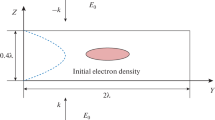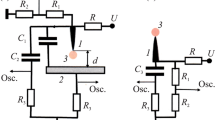Abstract
The development of a surface barrier discharge in nitrogen containing 0.1 wt % of O2 impurity is numerically simulated in a 2D model of a continuous medium under conditions of a pressure in the range of 2–8 atm and positive step voltage pulse amplitudes of 20–50 kV. The development of a thin plasma layer with a density that increases with time is noticed at a voltage of 40 kV and nitrogen pressures above 4 atm. This layer is a filament that develops at the streamer boundary that faces the dielectric and moves toward the dielectric surface with time. It is shown that the reason for the development of the filament is stepwise ionization from the excited states of the nitrogen molecule. A criterion for the appearance of the filament is proposed that agrees with the experimental data at the qualitative level, according to which the threshold voltage for this phenomenon decreases with increasing pressure.













Similar content being viewed by others
REFERENCES
K. D. Bayoda, N. Benard, and E. Moreau, J. Appl. Phys. 118, 063301 (2015).
A. Y. Starikovskii, A. A. Nikipelov, M. M. Nudnova, and D. V. Roupassov, Plasma Sources Sci. Technol. 18, 034015 (2009).
A. Starikovskiy and N. Aleksandrov, Prog. Energy Combust. Sci. 39, 61 (2013).
S. M. Starikovskaia, J. Phys. D: Appl. Phys. 47, 353001 (2014).
S. A. Stepanyan, A. Yu. Starikovskiy, N. A. Popov, and S. M. Starikovskaia, Plasma Sources Sci. Technol. 23, 045003 (2014).
S. A. Shcherbanev, C. Ding, S. M. Starikovskaia, and N. A. Popov, Plasma Sources Sci. Technol. 28, 065013 (2019).
C. Ding, A. Yu. Khomenko, S. A. Shcherbanev, and S. M. Starikovskaia, Plasma Sources Sci. Technol. 28, 085005 (2019).
S. A. Shcherbanev, N. A. Popov, and S. M. Starikovskaia, Combust. Flame 176, 272 (2017).
V. R. Soloviev, E. M. Anokhin, and N. L. Aleksandrov, Plasma Sources Sci. Technol. 29, 035006 (2020).
V. R. Soloviev and V. M. Krivtsov, J. Phys. D: Appl. Phys. 42, 125208 (2009).
V. R. Soloviev and V. M. Krivtsov, Plasma Sources Sci. Technol. 27, 114001 (2018).
G. Wormeester, S. Pancheshnyi, A. Luque, S. Nijdam, and U. Ebert, J. Phys. D: Appl. Phys. 43, 505201 (2010).
M. B. Zheleznyak, A. Kh. Mnatsakanyan and S. V. Sizykh, High Temp. 20, 357 (1982).
N. A. Dyatko, I. V. Kochetov, and A. P. Napartovich, Plasma Phys. Rep. 18, 462 (1992).
G. E. Georghiou, A. P. Papadakis, R. Morrow, and A. C. Metaxas, J. Phys. D: Appl. Phys. 38, R303 (2005).
I. A. Kossyi, A. Yu. Kostinsky, A. A. Matveyev, and V. P. Silakov, Plasma Sources Sci. Technol. 1, 207 (1992).
N. L. Aleksandrov, A. E. Bazelyan, E. M. Bazelyan, and I. V. Kochetov, Plasma Phys. Rep. 21, 57 (1995).
J. Bacri and A. Medani, Physica B + C 112, 101 (1982).
L. M. Biberman, V. S. Vorob’ev, and I. T. Yakubov, Sov. Phys.–JETP 29, 1070 (1969).
B. M. Smirnov, Ions and Excited Atoms in Plasma (Atomizdat, Moscow, 1974), pp. 264, 271 [in Russian].
V. R. Soloviev and V. M. Krivtsov, J. Phys.: Conf. Ser. 927, 012059 (2017).
B. M. Smirnov, Ions and Excited Atoms in Plasma (A-tomizdat, Moscow, 1974), p. 203 [in Russian].
N. D. Lepikhin, A. V. Klochko, N. A. Popov, and S. M. Starikovskaia, Plasma Sources Sci. Technol. 25, 045003 (2016).
N. D. Lepikhin, N. A. Popov, and S. M. Starikovskaia, Plasma Sources Sci. Technol. 27, 055005 (2018).
ACKNOWLEDGMENTS
The author is grateful to N.A. Popov for his support of this study and enlightening comments.
Funding
This study was supported by the Russian Science Foundation (grant no. 22-29-00084).
Author information
Authors and Affiliations
Corresponding author
Ethics declarations
The author declares that he has no conflicts of interest.
Additional information
Translated by O. Kadkin
Rights and permissions
About this article
Cite this article
Soloviev, V.R. Filament Formation Mechanism for a Nanosecond Surface Barrier Discharge of Positive Polarity in Nitrogen. Plasma Phys. Rep. 48, 669–681 (2022). https://doi.org/10.1134/S1063780X22600311
Received:
Revised:
Accepted:
Published:
Issue Date:
DOI: https://doi.org/10.1134/S1063780X22600311




